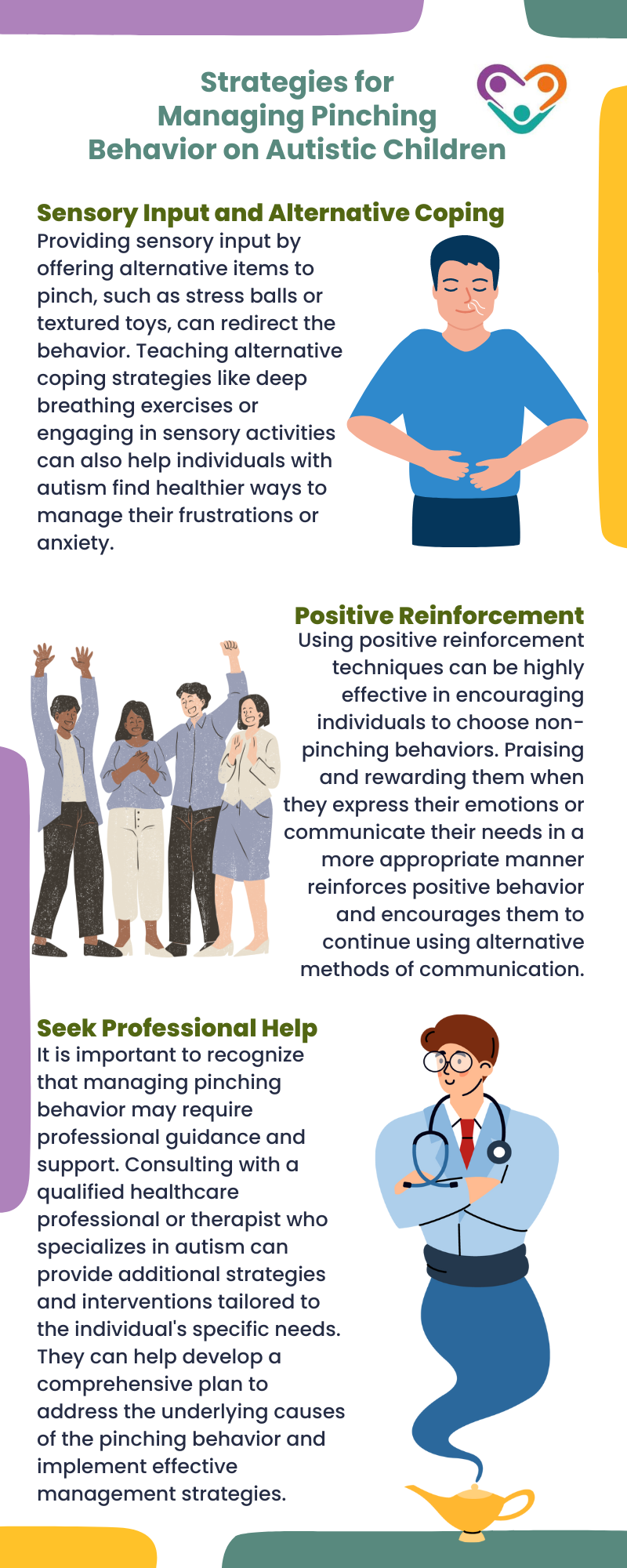Pinching behavior in children with autism can be a common occurrence, and understanding the reasons behind it is crucial in effectively managing and addressing the behavior.
Due to this, parents and caregivers should have a clear understanding of the common reasons for pinching and when to seek professional advice.

Common Reasons for Pinching
Pinching behavior in autistic individuals can serve various purposes and may be driven by different underlying factors. Here are some of the most common reasons:
- Seeking Attention – Children with autism may engage in pinching as a way to seek attention from others. They may use this behavior to elicit reactions or to communicate their needs or desires.
- Communication: Pinching can also be a form of communication for individuals with autism. It may be their way of expressing discomfort, frustration, or a need for sensory input.
- Escape from Situations – Pinching behavior can occur as a means of escape from overwhelming or stressful situations. It may serve as a coping mechanism for individuals with autism to regulate their sensory experiences or to avoid certain demands or social interactions.
- Sensory Issues – Some individuals with autism may exhibit pinching behavior due to sensory sensitivities or seeking sensory stimulation. The act of pinching may provide the desired sensory input or help them regulate their sensory system.
- Anxiety – Pinching behavior can also be a result of anxiety or emotional distress. Individuals with autism may resort to pinching as a way to self-soothe or relieve anxiety in challenging situations.
Understanding the specific reasons behind pinching behavior in individuals with autism is essential in developing appropriate strategies and interventions to address the behavior effectively.

Seeking Professional Advice
If the pinching behavior in a child with autism is aggressive and persistent similar to rage attacks, then it’s time to seek professional advice. Consulting with a healthcare professional, such as a pediatrician, developmental psychologist, or behavior analyst, can provide valuable guidance and support in assessing the behavior and developing a comprehensive intervention plan.
Professional advice can help determine the underlying factors contributing to the pinching behavior and tailoring strategies to address it effectively. They can provide insights into behavior management techniques, communication strategies, and sensory interventions that can assist in reducing the frequency and intensity of pinching incidents.
Reacting calmly to pinching incidents, removing the child from the situation with limited interaction, and providing alternative sensory stimuli like stress balls, fidget tools, or sensory play can also be effective strategies for managing the behavior.
Remember, seeking professional advice and assistance is crucial to ensure that the pinching behavior is addressed appropriately and that the child receives the necessary support and guidance in managing their behavior effectively.

Managing Pinching Behavior
Addressing and managing pinching behavior in children with autism requires a thoughtful and proactive approach. Fortunately, you can implement certain strategies to manage pinching incidents effectively. These strategies are as follows:
Diary Tracking and Analysis
Keeping a diary to record pinching episodes, triggers, and behaviors before the incidents can be a valuable tool for parents and caregivers. By tracking and analyzing these patterns, it becomes easier to identify the underlying reasons for the pinching behavior in autistic children.
This information can guide the development of appropriate strategies and interventions to address the behavior effectively.
A diary can include details such as the time and location of the incidents, any specific triggers or events that preceded the pinching behavior, and the child’s reaction before and after the incident. This information can provide valuable insights into the factors contributing to the behavior and help tailor interventions accordingly.

Positive Reinforcements and Visual Aids
Providing positive reinforcements and using visual aids can play a crucial role in managing pinching behavior.
Praising positive actions and using visual aids like social stories or visuals during times of frustration can assist in guiding positive behaviors and calming down autistic children prone to pinching behavior.
Positive reinforcements can include verbal praise, rewards, or tokens that are given when the child displays appropriate behavior or uses alternative strategies to communicate their needs or frustrations.
Visual aids, such as visual schedules or visual prompts, can help children understand and follow routines, reducing anxiety and minimizing the likelihood of pinching incidents.
Maintaining Patience and Consistency
Patience, persistence, and consistency are essential when dealing with pinching behavior in children with autism. It is important to understand that pinching behavior often stems from distress or frustration rather than intentional misconduct.
Recognizing this can help parents and caregivers approach the behavior with empathy and understanding.
Maintaining consistency in expectations and responses is crucial for managing pinching behavior. Simple, clear commands and instructions can help the child understand expectations and boundaries. Limiting eye contact during times of distress can also be helpful, as direct eye contact may exacerbate the child’s anxiety or frustration.
Risks and Effective Strategies
Pinching behavior in individuals with autism presents various risks both for the individuals themselves and those around them. However, with effective management strategies and redirection techniques, the risks associated with pinching behavior can be minimized.
Risks of Pinching Behavior
The most obvious risk of autism pinching behavior is the potential for injury and physical harm. When engaging in pinching behavior, there is a possibility of causing injury to oneself or others.
If the skin is broken, victims may experience bleeding or infection which further complicates the situation.
In addition to physical risks, pinching behavior may also impact the formation of social relationships. The act of pinching can lead to strained interactions with family members, friends, or peers, as it may be perceived as aggressive or intrusive.
This can create difficulties in building and maintaining positive social connections, which are important for overall well-being and quality of life.
Effective Management Strategies
To effectively manage pinching behavior in individuals with autism, it is crucial to implement strategies that address the underlying causes and provide alternative outlets for communication and self-expression.
Here are some effective strategies to consider:

Redirecting Pinching Behavior
Redirecting pinching behavior involves providing alternatives for individuals with autism to express their frustrations or anxiety without resorting to pinching. This can be achieved through various techniques, including:
- Providing Alternative Communication Tools – Encouraging individuals to find alternative ways to communicate their needs, such as using visual aids, sign language, or assistive communication devices, can help reduce the likelihood of pinching behavior.
- Teaching Emotion Regulation Skills – Teaching individuals with autism emotion regulation techniques, such as deep breathing exercises or engaging in calming activities, can provide them with alternative coping mechanisms to manage their emotions and reduce the urge to pinch.
- Creating Structured Environments – Creating a structured environment with clear expectations and routines can help individuals with autism feel more secure and reduce stress and anxiety, which may contribute to pinching behavior.
By implementing these effective management strategies, individuals with autism can learn alternative ways to express themselves and manage their emotions, reducing the risks associated with pinching behavior.
It is important to remember that each individual is unique, and a personalized approach that considers their specific needs and challenges is essential for successful management.
Research continues to shed light on the neurological basis of sensory issues in autism, offering hope for more targeted and effective therapies in the future. By recognizing and addressing sensory processing difficulties, we can improve the quality of life for individuals with autism and their families. If you’re seeking specialized ABA therapy in New Jersey, Indiana, Georgia, and New York, Golden Care offers comprehensive services tailored to meet the unique needs of each individual. Contact us to learn more or book a consultation today.
Sources:
https://www.autismparentingmagazine.com/autism-pinching-behavior
https://www.autismspeaks.org/expert-opinion/autism-pinching-behavior
https://www.kindship.com.au/blog/how-to-stop-my-autistic-child-from-pinching-me
https://autism.org/causes-and-interventions-for-self-injury-in-autism



